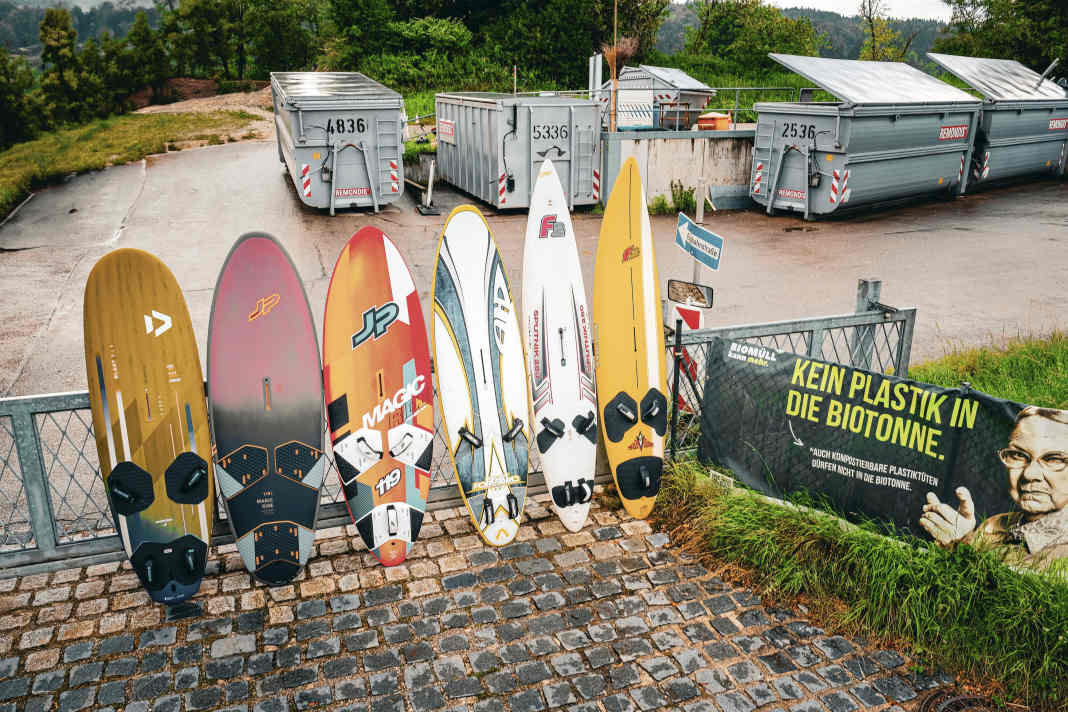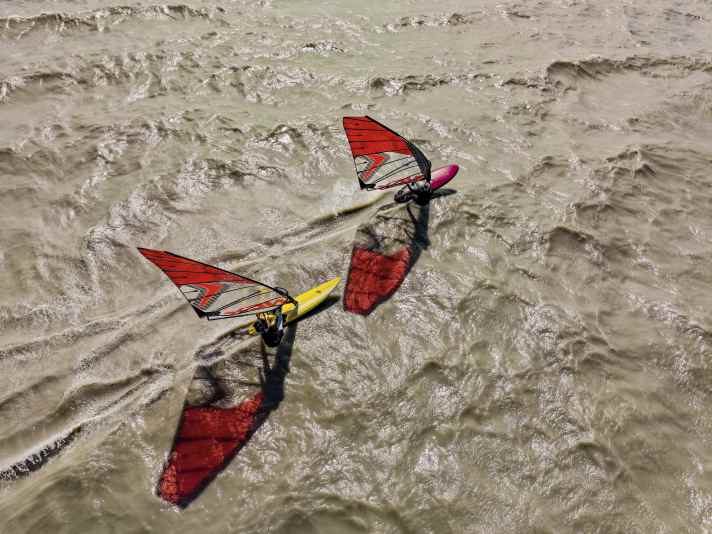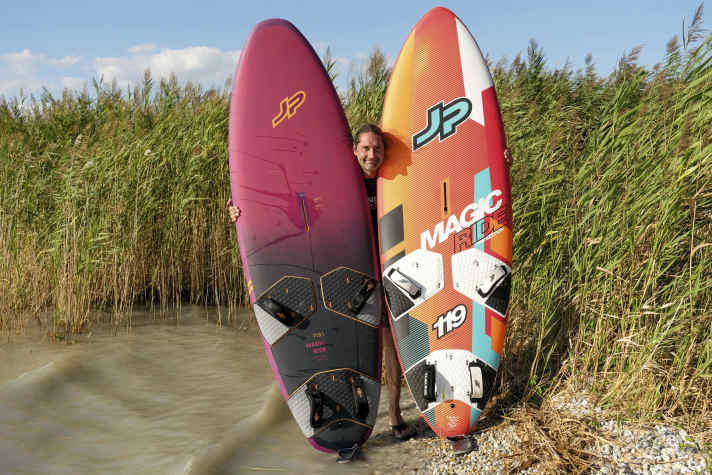Freeride boards: Board evolution - Oldtimers and Youngtimers against modern boards
Stephan Gölnitz
· 14.10.2025






"We'll definitely surf the Horst first!" We immediately agreed on that. The white Sputnik 280 has a magical appeal among the hodgepodge of new and historic shapes that we had carted to Lake Neusiedl. "Horst", someone lovingly signed in felt-tip pen next to the mast track a long time ago. Whether it was named after the hapless gallop racer Horst from 1999's movie "Bang Boom Bang" or whether the former owner was called Horst is unknown. In any case, the board has already had a decade of reprieve in the takeaway bin outside a surf shop and a short but successful career as a children's race SUP in the 2010s.
More on the topic:
Freerideboards: 1997 until today
Now the 90s shape is allowed to let off steam one last time in its traditional habitat. Franky grabs the racy board first. As he tries to plane off the Illmitz promenade, the board rises steeply in the water like the ski jump in Innsbruck, Franky disappears up to his knees in the Neusiedler swamp, with only the tip of the board sticking out like the last few centimetres of the "Titanic". How can 105 litres have so little buoyancy? Archimedes' law doesn't seem to apply to boards with a super narrow tail. Less than ten minutes later, the tester returns from the water euphoric: "I've just done the fastest jibe of my life! But this thing is more demanding than my 70-litre waveboard." The 105 litre volume is spread over a length of 2.80 metres and a width of 54 centimetres, which is closer to the ideal proportions of a Nordic spruce trunk than those of a windsurfing board suitable for everyday use. We haven't seen Franky's super jibe, but the choppy water rodeo is all the better.
The Sputnik 280 is more wobbly than my 70-litre waveboard."
A visit to Shape legend Werner Gnigler
The day before, we had visited Werner Gnigler. He shaped the current JP boards, and in his office there are still the yellowed folders with all the shape data of the F2 range going back to the nineties. "Back then, it was all about speed," Werner recalls as he flicks through the files. "World Cup pros like Bjørn had at least one board for every race sail and always tried to ride the narrowest one. In order to have any chance of planing on it, the boards had to be long enough to compensate - in line with the motto 'length runs'.
This shape philosophy has also been transferred to the freeride boards. So we put the freeride representative of the late nineties, the canary yellow F2 Ride 282, up against the current Magic Ride. The Ride is a whopping 14 centimetres narrower and seemingly infinite 40 centimetres longer. "The bend in the nose was insane," Werner had noted with amusement the day before. "The old ride had a 30-centimetre scoop. Today, freeride boards are just over 20 centimetres." The old classics, such as our Ride 282 or the Xantos series, surfed on straight planing surfaces of one metre or even 1.10 metres in length; today, 80 centimetres is the freeride standard. Back then, a flat planing angle from the planing surface to the 30 centimetre upturn at the nose was only possible with a long overall length.
On the water, after the extremely wobbly bobbing, we feel what some surfers appreciated so much in the perhaps somewhat watered-down memory of the old boards. On the one hand, the long ride chugs off quite quickly when not planing and then runs higher over the water, at least with the nose, than any current board. The pointed nose is more likely to spear a low-flying seagull than to stab into a choppy wave - which is one of the primal fears of many surfers. During the first comparison run, there is a lot of wind with a real pull on the boom. The Ride glides almost on a par with the latest Magic Ride. Both accelerate quickly, and on deep space courses we paint two foam stripes on the murky lake, as synchronised as if we were flying in formation. The Ride requires a lot of body tension, it needs to be tipped cleanly onto the leeward edge and held firmly there. This is not a cockpit for little legs with undersized shin muscles. The board rolls slightly in lateral waves - but all in all, the yellow torpedo races across the lake with little resistance and very good top speed. Have 25 years of development been for the bin?
Fast, but only with a lot of effort
"The old boards were really fast at top speed," Werner Gnigler had warned us, "but for the hobby surfer, the average speed is much more important and how easy it is to get it out." The second test run in less wind makes the still freshly shining Ride, which we had pulled out of the "Surftools" shop as good as new, actually look pretty old. The wind fluctuates between the middle and lower planing range, the Magic Ride lies almost stoically on the water at the ideal planing angle after planing, allows a lot of pressure to be applied to the fin and doesn't hit the bow any harder than the pickup in a "cosy rock" LP. The ride, on the other hand, does what it wants without any solid body tension: the bow flips up and down, the long planing surface crashes into the short choppy wave, although the pointed nose points into the sky like an Ariane 6 on an ESA mission.

The old Ride simply lacks an independent lift in the middle wind range. The reason for this is the strong V in the rear glide area. "You can't just look at the ruler on the side of the V, you have to compare the angle." Werner Gnigler shows the common mistake made during the assessment: "If I measure the same value on the side of a 20 centimetre wider board as on the narrow board, the angle is much flatter. The old freeride boards had 1.5 to 2 centimetres on the edge, even though they were so narrow. This was done to give the boards a better edge and for control. But it also means the board sits more firmly in the water."
Buoyancy due to a flat underwater hull
Although current boards often have a dampening V or an absorbing concave under the mast track, the shape under the straps is usually rather unspectacular - because a flat underwater hull provides the most lift. "We want a lot of lift in the planing area to give the board a free planing position," explains Werner. And this works perfectly in the practical test: while the old F2 Ride can only be pressed onto the leeward edge and into a free planing position with the front shin muscle under high tension, the Ride - like many modern boards - still "hovers" high and freely through wind holes on the wide, almost flat tail even when the rider is just hanging on the boom in a deeply relaxed position. For this reason, and to ensure a high degree of inherent stability and the best gliding properties, the boards became wider and wider until eight or ten years ago. In the meantime, some of them have "come apart" too much.
The AHD 117, circa model 2010, represents the intermediate generation in this test. It is 2.50 metres long and 67.5 centimetres wide. This makes the board more wobbly than the new Magic Ride when loose-chugging, but no longer as "old-school" as the yellow Ride. The nose is already wider, the planing position is still a little deeper and fuller, but the nose is more moderately curved and therefore somehow more "familiar". With identical fins, the AHD surfs consistently behind the Magic Ride. The fuller water position - which also lacks dynamic lift in the tail - feels comfortable and damped, but costs performance in all gears.
The wobbly straps and hyperextended ankles are much more of a nuisance than the loss of performance. The pads are particularly thick under the heels. This is no longer done today. The AHD is the surfing youngtimer in this test. A board like this can still pass as a "daily driver". However, you shouldn't expect the same comfort and performance of a current board.
Some shapes have overshot the mark
The orange 2015 Magic Ride should be able to do this better. The last three generations of Magic Rides measured 239/76, 240/75 and 241/74, and the era of maximum width boards has since passed. "Every trend overshoots the mark at some point," says Werner, justifying the step back. "We quickly recognised the advantages of the first significantly wider boards. Then there was a real hype, and it wasn't until a little later that people realised that the very short boards didn't glide so well after all." In our test, however, the penultimate generation of the Magic Ride (240/75) fared quite well against the current board (241/74). A difference in riding feel is hardly noticeable. However, the latest shape glides longer and more stable through the jibe with a stretched outline and revised edge radius.

The ongoing fine-tuning during development - the proverbial finishing touches - is responsible for this. Like the rail shape, for example. "Today, we look more at the finer details when we're fine-tuning the model," says Werner, running his finger over the rail and searching for the point of greatest width. "The apex point, for example, the point at which the maximum width is at the edge. If it's too low, water spills over the deck when you start planing, the board sucks up and you also have less lift in the jibe. The board then stops earlier. And the way the water splashes off the side of the rail is also determined by the edge shape. We are always working on these things." In surf tests, the particularly wide boards with a round outline and particularly thin rails often performed less well with wide, sporty planing necks. "The lift was not balanced on boards with a round outline and a narrow tail in the jibe," explains Werner. "If the tail and centre width are more balanced, it's much easier to maintain speed in the jibe."
Wide boards with high buoyancy are simply more relaxed to ride. On long distances as well as in the jibe."
Loading up the old fleet also makes me think wistfully of my beloved 1977 Hanomag bus, which has long since been scrapped. But after a millisecond, immersed in 60 hp romanticism, I realise - as I did after this board test - that the long journey back from Lake Neusiedl will be infinitely more pleasant in the comfortable editorial van.
Old vs. new boards - the surf conclusion
- If an old banana actually overtakes you in strong winds: don't worry, the boards were already fast back then - with a lot of pressure in the sail. But in the next wind hole, in an ideal planing wind, on average over long distances and at the latest in the jibe, modern boards offer noticeably more performance, safety and comfort.
- Freeride boards over 2.60 metres long or under 65 centimetres wide (for boards over 110 litres in volume) are not a "gift" even for zero euros in the classifieds - you're actually just disposing of them or making your surfing career more than unnecessarily difficult.
- You can buy freeride boards from the last ten years almost without hesitation.

